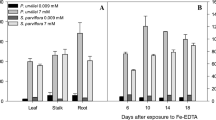Abstract
The presented investigations have been carried out in order to estimate toxic sulphide levels and to examine detoxification capabilities in roots and rhizomes of the common reed (Phragmites australis).
Underground organs of common reed are sensitive towards sulphide above 1 mM applied exogenously under hypoxia. However, certain tolerance may be achieved by sulphide detoxification. Accumulated sulphide is partially used for the synthesis of non-toxic thiols, mainly glutathione. But the detoxification capacity of the underground organs is limited. Maximum concentrations of thiols are about 60 nmol/g−1 fw in roots and 300 nmol/g−1 fw in rhizomes.
Energy metabolism is considerably affected by low sulphide concentrations of 1 mM for 4 days, and immediately disturbed by increased concentrations up to 6 mM sulphide. Adenylate energy charge, total adenylates, posthypoxic respiration, and fermentation capacity decrease significantly. Roots are more sensitive than rhizomes.
Similar content being viewed by others
References
Armstrong J. &Armstrong W. (1988):Phragmites australis—a preliminary study of soil-oxidizing sites and internal gas transport pathways.New Phytol. 108: 373–382.
Armstrong J., Armstrong W. & van der Putten (1996):Phragmites die-back: bud a root death, blockages within the aeration and vascular system and the role of phytotoxins.New Phytol. (in press).
Armstrong W., Brändle R. &Jackson M.B. (1994): Mechanisms of flood tolerance in plants.Acta Bot. Neerl. 43: 307–358.
Bradford M.M. (1976): A rapid and sensitive method for the quantitation of microgram quantities of protein utilizing the principle of protein-dye binding.Analytical Biochem. 72: 248–254.
Bradley P.M. &Morris J.T. (1990): Influence of oxygen and sulfide concentration on nitrogen uptake kinetics inSpartina alterniflora.Ecology 7: 282–287.
Brändle R. (1983): Evolution der Gärungskapazität in den flut- und anoxiatoleranten Rhizomen vonPhalaris arundinacea, Phragmites communis, Schoenoplectus lacustris undTypha latifolia.Bot. Helv. 93: 39–45.
Bucher M. &Kuhlemeier C. (1993): Long-term anoxia tolerance. Multi-level regulation of gene expression in the amphibious plantAcorus calamus L.Pl. Physiol. 103: 441–448.
Crawford R.M.M. (1992): Oxygen availability as an ecological limit to plant distribution.Advances Ecol. Res. 23: 93–185.
Grill D. &Esterbauer H. (1973): Quantitative Bestimmung wasserlöslicher Sulfhydrylverbindungen in gesunden und geschädigten Nadeln vonPicea abies.Phyton (Horn) 15: 87–101.
Hock B. &Elstner E.F. (1988):Schadwirkungen auf Pflanzen. Lehrbuch der Pflanzentoxikologie. BI-Wissenschaftsverlag, Mannheim.
Koch M.S. &Mendelssohn I.A. (1989): Sulphide as a soil phytotoxin: Differential responses in two marsh species.J. Ecol. 77: 565–578.
Koch M.S., Mendelssohn I.A. &McKee K.L. (1990): Mechanism for the hydrogen sulfide-induced growth limitation in wetland macrophytes.Limnol. & Oceanogr. 35: 399–408.
Melzer A. &Steinberg C. (1983): Nutrient cycling in freshwater ecosystems. (In:Pirson A. &Zimmermann M.H. (eds.), Encyclopedia of plant physiology. New Series Vol. 12D). In:Lange O.L., Nobel P.S., Osmond C.B. &Ziegler H. (eds.),Physiological plant ecology IV. Ecosystem processes: Mineral cycling, productivity, and man's influence, Springer Verlag, Berlin, pp. 47–84.
Ostendorp W. (1989): “Die-back” of reeds in Europe—a critical review of literature.Aquatic Bot. 35: 5–26.
Pearson J. &Havill D.C. (1988): The effect of hypoxia and sulphide on culture-grown wetland and non-wetland plants. II. Metabolic and physiological changes.J. Exp. Bot. 39: 431–439.
Pezeshki S.R., Pan S.Z., Delaune R.D. &Patrick W.H., Jr. (1988): Sulfide-induced toxicity: Inhibition of carbon assimilation inSpartina alterniflora.Photosynthetica 22: 437–442.
Pradet A. &Raymond P. (1983): Adenine nucleotide ratios and adenylate energy charge in energy metabolism.Annual Rev. Pl. Physiol. 34: 199–224.
Rennenberg H. &Lamoureux G.L. (1990): Physiological processes that modulate the concentration of glutathione in plant cells. In:Rennenberg H. et al. (eds.),Sulfur nutrition and sulfur assimilation in higher plants, SPB Academic Publishing, The Hague, pp. 53–65.
Rüegsegger A. &Brunold C. (1992): Effect of cadmium on γ-glutamylcysteine synthesis in maize seedlings.Pl. Physiol. 99: 428–433.
Sieber M. &Brändle R. (1991): Energy metabolism in rhizomes ofAcorus calamus (L.) and in tubers ofSolanum tuberosum (L.) with regard to their anoxia tolerance.Bot. Acta 104: 279–282.
Siegel L.M. (1965). A direct microdetermination for sulfide.Analytical Biochem. 11: 126–132.
Vismann B. (1991): Sulfide tolerance: Physiological mechanisms and ecological implications.Ophelia 34: 1–27.
Weber M. &Brändle R. (1996): Some aspects of the extreme anoxia tolerance of the sweet flag,Acorus calamus L.Folia Geobot. Phytotax. 31: 37–46.
Author information
Authors and Affiliations
Rights and permissions
About this article
Cite this article
Fürtig, K., Rüegsegger, A., Brunold, C. et al. Sulphide utilization and injuries in hypoxic roots and rhizomes of common reed (Phragmites australis). Folia Geobot 31, 143–151 (1996). https://doi.org/10.1007/BF02804003
Issue Date:
DOI: https://doi.org/10.1007/BF02804003




